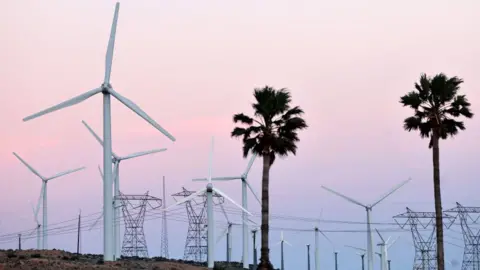The landscape of green energy in the United States is on the verge of facing significant changes as federal funding cuts loom large over the industry. This situation creates uncertainty for various companies, particularly for those pioneering projects related to renewable energy solutions. The ongoing economic adjustments, heavily influenced by legislative debates, have the potential to reshape the future of this vital sector in American infrastructure and environmental strategy.
One illustrative example of the potential impact of these funding cuts can be observed in HIF Global’s ambitious plans for a $7 billion e-methanol production facility in Matagorda County, Texas. The company envisions this project as a pioneering effort to create a facility that would utilize captured carbon dioxide alongside green hydrogen sourced from renewable energy to produce e-methanol. This advanced facility, touted as potentially the largest of its kind globally, aims to contribute to cleaner energy solutions for the aviation and shipping sectors. Despite the project’s promising scope, HIF Global awaits crucial decisions from Congress regarding tax credits, particularly for clean hydrogen production, which are essential for the project’s financial viability.
The broader implications of these potential funding cuts are profound. The Senate is currently reviewing a budget bill that includes sweeping modifications to clean energy tax credits, with the Republican-led House already passing a version that proposes cuts to essential subsidies including those for hydrogen production. This legislative climate has led to a heightened sense of uncertainty among companies in the green energy sector. As Lee Beck, HIF Global’s senior vice president for global policy and commercial strategy notes, the implications of losing the clean hydrogen tax credit would severely hinder US competitiveness against foreign e-methanol producers.
The adverse effects of administrative actions are reminiscent of previous political hostilities toward renewable energy. Under the Trump administration, green energy faced significant backlash, with initiatives like the withdrawal from the Paris climate agreement and halting renewable energy projects on federal lands. Furthermore, the opposition to the Green New Deal funding signaled a broader skepticism toward federal investments in cleaner technologies and sustainable practices.
Amid these challenges, the clear message from industry stakeholders is one of caution and concern. Jessie Stolark, executive director of the Carbon Capture Coalition, articulated the feeling of uncertainty that has permeated project funding since the IIJA’s introduction. While existing funding has been awarded, there remains a lack of clarity regarding future phases of project financing. This uncertainty could have devastating effects on the nascent carbon management industry, jeopardizing its long-term growth and viability.
The political landscape remains complex, as the future of the Inflation Reduction Act (IRA) and the IIJA hangs in the balance. The budget bill proposed is marked by efforts to extend President Trump’s tax cuts while making reductions elsewhere, which may impact the green energy tax credits set to expire over the next decade. Critics of the Biden administration’s green investments argue that the costs associated with these initiatives could become a substantial burden on taxpayers, inciting calls for repeal from conservative think tanks, such as the Cato Institute.
Recent reports illustrate concerning trends in actual clean energy investments in the United States, which saw a notable decline of 3.8% in the first quarter of 2025. This downturn is attributed to several factors, including high inflation and interest rates. The uncertain policy environment under the new administration has made investors hesitant, leading to a record number of project cancellations. These trends suggest that without a stable framework for green energy, the forward momentum vital to the sector is at risk.
As firms navigate these turbulent waters, some have already begun shifting their marketing strategies to emphasize local production and efficiency, adapting to stakeholder priorities. The aviation fuel company LanzaJet, for instance, has modified its outreach to focus less exclusively on climate change, showcasing its commitment to harnessing locally sourced materials.
With each passing day, green energy firms must closely monitor legislative developments, as the stakes could determine the viability of many proposed projects across the country. As the industry braces for potential funding cuts, the future of clean energy initiatives in the United States hangs precariously, underscoring the critical need for strategic policy-making that balances economic realities with environmental imperatives.



